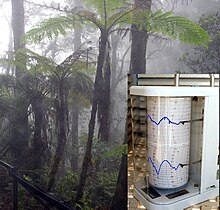Wet bulb temperature
| Humidity and hygrometry | |
|---|---|
 |
|
| Specific concepts | |
| General concepts | |
| Measures and Instruments | |
|
|
The wet-bulb temperature is the temperature a parcel of air would have if it were cooled to saturation (100% relative humidity) by the evaporation of water into it, with the latent heat being supplied by the parcel. A wet-bulb thermometer will indicate a temperature close to the true (thermodynamic) wet-bulb temperature. The wet-bulb temperature is the lowest temperature that can be reached under current ambient conditions by the evaporation of water only. Wet-bulb temperature is largely determined by both actual air temperature (dry-bulb temperature) and the amount of moisture in the air (humidity). At 100% relative humidity, the wet-bulb temperature equals the dry-bulb temperature.
The thermodynamic wet-bulb temperature is the lowest temperature which may be achieved by evaporative cooling of a water-wetted (or even ice-covered), ventilated surface.
By contrast, the dew point is the lower temperature, to which the ambient air must be cooled to reach 100% relative humidity assuming there is no evaporation into the air; it is the point where condensate (dew) and rain would form.
For a parcel of air that is less than saturated (i.e., air with less than 100 percent relative humidity), the wet-bulb temperature is lower than the dry-bulb temperature, but higher than the dew point temperature. The lower the relative humidity (the drier the air), the greater the gaps between each pair of these three temperatures. Conversely, when the relative humidity rises to 100%, the three figures coincide.
For air at a known pressure and dry-bulb temperature, the thermodynamic wet-bulb temperature corresponds to unique values of the relative humidity and the dew point temperature. It therefore may be used for the practical determination of these values. The relationships between these values are illustrated in a psychrometric chart.
...
Wikipedia
